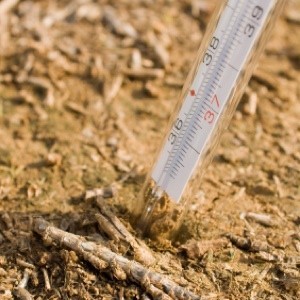 Gardeners can't always rely solely on the calendar to tell them when it's time to plant, especially when it comes to measuring the temperature of the soil. Plants that are started in cold soils may grow slowly, develop poorly, or succumb to disease-IF they ever get off the ground at all! Here's what you need to know about soil temperature and the adverse affects that too-cool soils can have on your plants.
Gardeners can't always rely solely on the calendar to tell them when it's time to plant, especially when it comes to measuring the temperature of the soil. Plants that are started in cold soils may grow slowly, develop poorly, or succumb to disease-IF they ever get off the ground at all! Here's what you need to know about soil temperature and the adverse affects that too-cool soils can have on your plants.
Life is fragile, so seeds are fussy. They are happy to put forth the extraordinary effort needed to produce a plant, providing of course, that the conditions are just right. Soil temperature, light, and moisture all work together to trigger seed germination. When the soil is cold, the seed may not germinate in the ground. If it does, it may be weak and lack the strength and vigor needed to develop properly, and may be at greater risk of succumbing to pests and disease.
Heat is the catalyst for many biological processes. When soil temperatures are low (and biological processes slow), certain nutrients are made unavailable or less available to plants. This is particularly true in the case of phosphorus, which is largely responsible for promoting the development of roots and fruit in plants. So, no heat = less nutrients = poor growth.
The answer to this depends on what type of seeds you are trying to germinate and/or what type of plants you are trying to grow. Most cool season vegetable crops will germinate when soil temperatures reach the mid-40's to mid 50's. They grow best when in daytime air temperatures of between 60-80 degrees F. Warm season vegetables crops prefer soil temperatures in the mid 50's to mid 60's for germination and need summer-like air temperatures (70-95 degrees F) to achieve optimal growth.
Many extension agencies websites and gardening books include charts listing both the minimum and optimum temperature ranges for vegetable seed germination and growth. Here is an example from the Alabama Cooperative Extension System:www.aces.edu
Flower seeds have soil temperature preferences, too. Check the back of seed packets for specific instructions.
An easy way to take the guesswork out of calculating soil temperatures is to use a soil thermometer. From the low-tech dial probes to thermometers with high-tech digital read-outs and automatic shut-off features, most hardware stores and garden centers carry them. Probe thermometers are designed to fit easily into your shirt pocket and are inexpensive ($7-$10). These will work just fine for most gardeners. Keep in mind that some thermometers do not give readings past 140 degrees F, so if you want a thermometer that will also read the temperature of your compost pile, look for one with a range that exceeds 160 degrees F.
To take a reading, simply insert the probe into the soil to the appropriate depth--2 inches for small seeds and early season crops, and 4 inches for warm season vegetables like tomatoes. Leave it there for at least 5 minutes before checking the results. Readings should be taken over a period of days, in different locations throughout the garden. Use a journal to record how the temperatures fluctuate daily and which part of your garden warms up first. This will help you when its time to plan next year's garden. Once the temperatures stay at the desired level for 3 days in a row, it is safe to plant.
Mother Natures takes her own sweet time to warm up soil temperatures in the spring. To speed up the process and avoid problems, gardeners can do several things:
Here are the questions asked by community members. Read on to see the answers provided by the ThriftyFun community.
What effect does soil temperature have on plant growth?
The soil temperature permits movement of the atoms in the plant necessary for plant life. Without a soil temperature (theoretically -459.67°F. (which itself is a temperature)), plants would be in a (theoretical) state of suspended animation.
There is an optimal 'growing' temperature for each plant. With millions of different plants, there are millions of different optimal temperatures. Soil temperatures above or below the optimal for any given plant will produce less than optimal growth.
Many vegetables, like tomatoes, beans, squash and peppers need soil temperatures to reach nearly 70ºF before their growth can really take off.